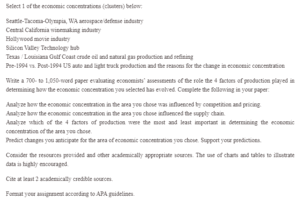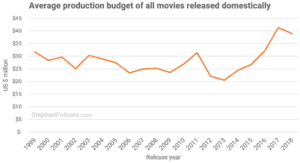Economic Concentration Evaluation
The film industry is among the industries growing rapidly across the world. Hollywood is currently dominating the global film industry due to various factors, such as its ability to deal with major financial losses, its popular appeal to customers, the exhibition networks under its management, and vast distribution networks. Hollywood is also supported by the United States government mainly because it plays a vital role in selling America to the world by displaying the culture of the American people. Hollywood has also been co-producing films with foreign companies and foreign languages to expand its market share. This review focuses on analyzing economic concentration in the Hollywood film industry and predicting changes in the industry.
The influence of completion and pricing in the economic concentration in the Hollywood movie industry.
Mixed and free economies include the concentration of economic power in the hands of a few, hence creating a monopoly. According to Turner (2019), monopoly is defined as the control of distribution and production of any product or service by any company or organization. The rising demand for high-quality films led to the emergence of various film production companies focusing on filling the gap left by other producers in the film industry. The increase in competition pushed Hollywood to improve the quality of its films and begin producing films in different languages to meet the needs of different audiences. The company invested in global and domestic markets to gain a more extensive customer base, hence creating a competitive advantage. In addition, the company began poaching talented actors and actresses and creating unique scripts to develop customer loyalty and attract more customers. The competition also influenced the market price for films, thus forcing Hollywood to adjust their prices based on the quality of movies produced. Besides increasing rivalry in the market, pricing also unified the producers because they had to agree on the standard price of films in different countries. Hollywood could, therefore, focus on global expansion and the quality of their films without worrying about their competitors’ prices.
The influence of economic concentration in the Hollywood movie industry on the supply chain
The demand of the audience dictates the production of films. This is particularly evident in series productions whereby films with a bad reception by the audience are not renewed for a subsequent season. In contrast, those with a good reception are renewed. Hollywood has gained dominance by supplying films to different parts of the world through online streaming platforms such as Netflix. The streaming sites also enable Hollywood to advertise its films to audiences. Production companies are also taking advantage of online streaming services to market their films, hence creating competition based on quality. However, the focus on quality has played a significant role in increasing the cost of producing films, as shown in the graph below.
Hollywood has also been using theaters and cinemas to increase the popularity of some of its major films. The use of cinemas has played a vital role in maintaining the supply of high-quality films because the company is able to raise money to sustain the production of more films and meet consumer demand.
The most and least important factors of production in determining the economic concentration of the Hollywood movie industry
Factors of production are the resources used in the production of goods and services (Rasmussen, 2011). The most important factors used to interpret the economic concentration of the Hollywood movie industry were capital and entrepreneurship. Hollywood’s success can be attributed to the availability of capital to sustain production and expand to global markets. Capital has also enabled the company to produce high-quality films despite the continued rise in the cost of production. Subsequently, Hollywood is one of the leading film producers with the best actors, thus implying that the company is able to invest in the best talent and retain them for future production. On the other hand, entrepreneurship was important because it enabled the company to generate ideas on how to increase profits and manage losses, hence maintaining a competitive advantage.
The least important factors are land and labor. Hollywood relies on talented employees to develop appealing scripts and actors and actresses who can bring out the intended performance. Labor was the least important in determining the industry’s economic concentration because it does not directly portray its financial performance. The land was also the least important because it did not represent its monetary value.
Predicted changes in the Hollywood movie industry
According to Burganov (2016), economic concentration is influenced by government policies, government regulation of financial institutions, the role of commercial banks, guidelines regulating large industrial houses, technological progress, investments among companies, managing agency systems, foreign collaboration, and strict import and taxation policy. The Hollywood movie industry could mainly be affected by government regulation, taxation policy, and technological progress. One of the changes that could occur for the industry is producing films with diverse casts to avoid discrimination and abide by government regulations on equality. The company may also change its production techniques by using technology to replace practical effects with artificial effects to reduce the cost of production. Further, the company may change the length of films to adjust to the financial conditions and reduce the budget for producing films, especially in foreign countries where the cost may be high due to travel and accommodation arrangements.
References
Burganov, R. (2016). The concentration of production and the economic concentration are systemic foundations of economic development. Journal of economic studies, 2(4), 3-3. https://doi.org/10.12737/21086
Rasmussen, S. (2011). The fixation of the production factors. Production Economics, 121-128. https://doi.org/10.1007/978-3-642-14610-7_12
Turner, J. R. (2019). Monopoly and monopoly price. Introduction to Economics, 582-601. https://doi.org/10.4324/9780429283529-26
ORDER A PLAGIARISM-FREE PAPER HERE
We’ll write everything from scratch
Question

Economic Concentration Evaluation
Select 1 of the economic concentrations (clusters) below:
Seattle-Tacoma-Olympia, WA aerospace/defense industry
Central California winemaking industry
Hollywood movie industry
Silicon Valley Technology hub
Texas / Louisiana Gulf Coast crude oil and natural gas production and refining
Pre-1994 vs. Post-1994 US auto and light truck production and the reasons for the change in economic concentration
Write a 700- to 1,050-word paper evaluating economists’ assessments of the role the four factors of production played in determining how the economic concentration you selected has evolved. Complete the following in your paper:
Analyze how the economic concentration in the area you chose was influenced by competition and pricing.
Analyze how the economic concentration in the area you chose influenced the supply chain.
Analyze which of the four factors of production were the most and least important in determining the economic concentration of the area you chose.
Predict changes you anticipate for the area of economic concentration you chose. Support your predictions.
Consider the resources provided and other academically appropriate sources. The use of charts and tables to illustrate data is highly encouraged.
Cite at least two academically credible sources.
Format your assignment according to APA guidelines.


